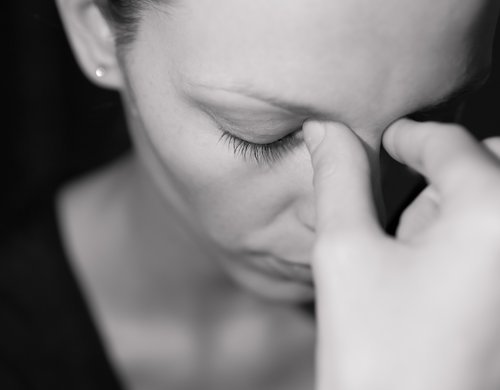
Osteopathy and treatment of the jaw (TMJ)
Nicolas Duchemin
Shoulder pain, neck pain, headaches, tinnitus, dizziness... What if it came from the jaw?
Very often, the osteopath is led to investigate the causes of the pain at a distance from the place where it is expressed by the patient. It is also not rare that the questioning, the examination and the fine palpation of the practitioner leads him/her to work on the jaw.
The jaw is composed of the mandible, a bony piece that supports the lower teeth and that articulates on either side of the skull, at the level of the temporal bone, just in front of the ear canal. Between these two bones is a disc (meniscus) that allows the bones to fit together perfectly, and many muscles and ligaments support the whole.
The jaw, also called the temporomandibular joint, is therefore at the crossroads of many structures and when these structures fail to function due to excessive contraction of the masticatory muscles, the jaw is no longer able to function. Here, the tensions of the different structures of the left temporomandibular joint caused such a compensation at the level of the cervical vertebrae that the muscles of the neck and the shoulder had to constantly compensate and the tensions at the level of the nerves dedicated to the upper limb near the cervical vertebrae caused a loss of sensation at the level of the fingers. In three sessions, Mrs. T. was able to see a clear improvement in the pain that had led her to consult the osteopath; at the same time, the osteopath suggested that she get in touch with her dentist in order to evaluate the usefulness of an occlusal plate to reduce the grinding of her teeth at night during periods of great stress.
With soft and adapted techniques, the osteopath will have to work in order to allow a return to the balance of the structures involved to find a harmony of functioning between the jaw, the teeth and the masticatory muscles, and to allow the optimal recovery of the various painful areas (local or at a distance) which brought to consult in the first place.
It is important to note that for an optimal result when one wishes to treat in depth the dysfunctions encountered, the notion of PLURIDISCIPLINARITY is extremely important here: dentists, orthodontists (fitting of occlusion disorders), speech therapists (re-education and posture of the tongue), psychologists (management of emotional components sometimes at the origin of certain bruxism and clenching of teeth). In some cases, all of them have a role to play and only a close cooperation between the different therapists will allow an efficient and global treatment.
Do not hesitate to ask your osteopath for advice in case of doubt!
Read article

Increase in post-treatment symptoms | Nicolas Duchemin, Osteopath D.O
Nicolas Duchemin
"We worked smoothly but the next day I felt like I had moved three times"
"I was tired and sore, like after a marathon"
Do these phrases sound familiar to you?
. . . . . . . . . .
Following an osteopathic treatment, it sometimes happens that you feel, a few hours or a few days after the consultation, various side effects, ranging from slight fatigue to frankly uncomfortable pains (these may be close to or at a distance from the treated area, and not always related to the reason that led you to consult your osteopath). This can happen even though a real relief of the symptoms was felt just after the consultation. But what is happening?
. . . . . . . . . .
During the treatment, the therapist has come to release one or more tensions that he will have been able to relate to the symptoms expressed by the patient: such a solicitation, even very gently, of one or more structures (connective tissues, muscles, tendons, viscera, fascias...) will force the body to react, to adapt, not only under the hands of the practitioner, but also during the days that follow the treatment. For example, the release of an ankle will lead to a lasting change in posture and walking; work on the liver will improve local blood circulation within the organ and increase its metabolic activity, etc... These processes are energy consuming and the gradual return to health may then go through phases of fatigue or discomfort. In addition, the therapist may have had to gently mobilize areas of acute or chronic inflammation in order to achieve relaxation. This sometimes causes a temporary increase in inflammation. Locally, there is a gain in amplitude or tissue quality, but the inflammation will disappear more slowly.
. . . . . . . . . .
Moreover, in people who consult for symptoms that have been present for a long time and for which the body has created multiple compensations over the years, or in patients with a rich history of traumas or various adaptations, it is not rare that the osteopath, by lifting a first chain (or "layer") of dysfunctions, lets another, older chain express itself, sometimes quietly, sometimes in a less comfortable way! It is also possible that the inflammation at the time of the visit is such that the practitioner was not able to release all the blockages during the first treatment and that they express themselves once the inflammation has passed. It will then be necessary to continue the treatment, letting the body do its work between the two sessions.
. . . . . . . . . .
This temporary way for the body to integrate the disappearance of tissue dysfunctions and to balance itself can take several forms, isolated or associated:
an increase in the symptoms that led to the consultation, but also:
fatigue
aches and pains
headaches
digestive problems
migrating joint pain (e.g. from shoulder to mid-back/knee, etc.)
neuralgia
skin reactions
.....
. . . . . . . . . .
The list is not exhaustive, but what we must keep in mind is that these discomforts when they occur are temporary (a few hours to several days), and testify to the transitory activity during which the body works to find a balance that has been lost for several days/months/years! This activity most frequently results in small areas of local inflammation leading to the above mentioned symptoms. Rest, patience, confidence in the body's ability to regain its health, as well as good communication with your osteopath are therefore indispensable assets in this adjustment phase.
It should be noted that these potential adaptations to the treatment vary in time and intensity depending on the reason for consultation, its acute or chronic nature, its age, the patient's lifestyle (physical activity, postures/efforts at work, diet, sleep, stress)... These are important data to take into account!
At the end of the consultation, the therapist systematically explains the possibility of these discomforts and the steps to follow if they persist for more than a few days (exercises, stretching, advancing the next appointment...). In all cases, it is strongly recommended to contact your osteopath (by phone or email) who, after discussing with you the effects felt, will be able to take the time to guide you in the best possible way for the continuation of the treatment.
. . . . . . . . . .
Nicolas Duchemin, Osteopath D.O.
nicolas.duchemin@cliniquealtermed.com


